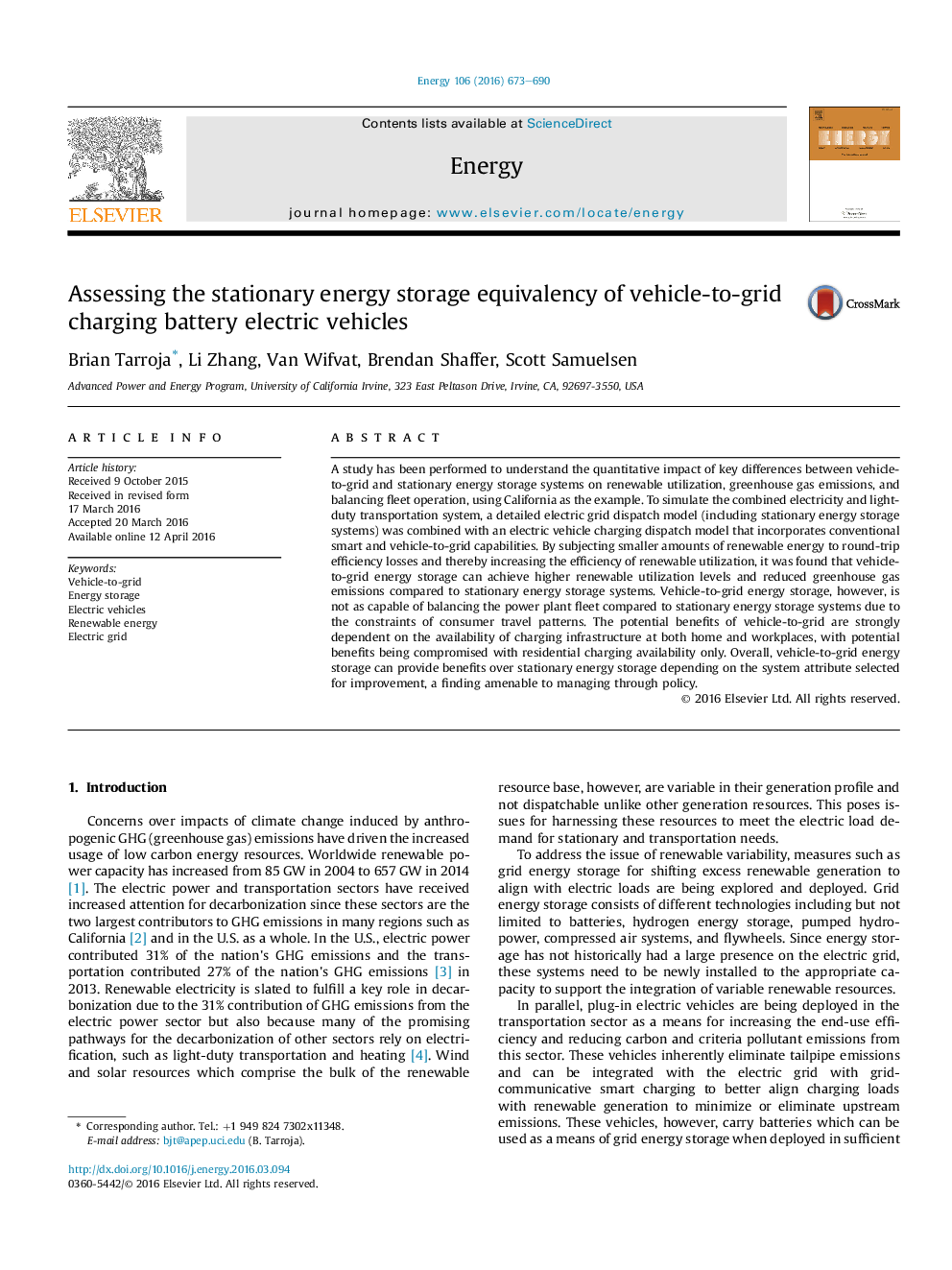| کد مقاله | کد نشریه | سال انتشار | مقاله انگلیسی | نسخه تمام متن |
|---|---|---|---|---|
| 1730992 | 1521442 | 2016 | 18 صفحه PDF | دانلود رایگان |
عنوان انگلیسی مقاله ISI
Assessing the stationary energy storage equivalency of vehicle-to-grid charging battery electric vehicles
ترجمه فارسی عنوان
ارزیابی معادل سازی ذخیره انرژی ثابت خودروهای الکتریکی باتری شارژ وسیله نقلیه به شبکه
دانلود مقاله + سفارش ترجمه
دانلود مقاله ISI انگلیسی
رایگان برای ایرانیان
کلمات کلیدی
خودرو به شبکه، ذخیره انرژی، وسایل نقلیه الکتریکی، انرژی تجدید پذیر، شبکه برق
ترجمه چکیده
یک مطالعه برای درک تاثیر کمی از تفاوت های کلیدی بین سیستم های ذخیره سازی انرژی به شبکه و سیستم های بر روی استفاده های تجدید پذیر، انتشار گازهای گلخانه ای و عملیات ناوگان متعادل، با استفاده از کالیفرنیا به عنوان مثال انجام شده است. برای شبیه سازی سیستم حمل و نقل ترکیبی الکتریکی و سبک وزن، یک مدل اعزام شبکه برق دقیق (از جمله سیستم های ذخیره سازی ثابت) با یک مدل ارسال مجدد شارژ الکتریکی همراه بود که قابلیت های معمولی هوشمند و وسیله نقلیه را به شبکه متصل می کرد. با در نظر گرفتن مقادیر کم انرژی تجدید پذیر برای زیان های بهره وری در دور سفر و در نتیجه افزایش بهره وری از تجدید پذیر استفاده می شود، متوجه شد که ذخیره انرژی انرژی به وسیله نقلیه می تواند سطوح بالاتر بهره برداری و کاهش انتشار گازهای گلخانه ای نسبت به سیستم های ذخیره سازی ثابت . با این حال، ذخیره سازی انرژی به وسیله نقلیه به دلیل محدودیت های الگوهای سفر مصرف کننده، قادر به متعادل کردن ناوگان نیروگاه در مقایسه با سیستم های ذخیره سازی ثابت نیست. مزایای بالقوه وسیله نقلیه به شبکه مستلزم دسترسی به زیرساخت های شارژ در هر دو خانه و محل کار می باشد، زیرا مزایای بالقوه تنها با دسترسی به شارژ مسکونی مواجه می شود. به طور کلی، ذخیره انرژی انرژی به شبکه می تواند مزایای ذخیره سازی انرژی ثابت را براساس ویژگی سیستم انتخاب شده برای بهبود فراهم کند، و یافته ای که بتواند از طریق سیاست مدیریت شود.
موضوعات مرتبط
مهندسی و علوم پایه
مهندسی انرژی
انرژی (عمومی)
چکیده انگلیسی
A study has been performed to understand the quantitative impact of key differences between vehicle-to-grid and stationary energy storage systems on renewable utilization, greenhouse gas emissions, and balancing fleet operation, using California as the example. To simulate the combined electricity and light-duty transportation system, a detailed electric grid dispatch model (including stationary energy storage systems) was combined with an electric vehicle charging dispatch model that incorporates conventional smart and vehicle-to-grid capabilities. By subjecting smaller amounts of renewable energy to round-trip efficiency losses and thereby increasing the efficiency of renewable utilization, it was found that vehicle-to-grid energy storage can achieve higher renewable utilization levels and reduced greenhouse gas emissions compared to stationary energy storage systems. Vehicle-to-grid energy storage, however, is not as capable of balancing the power plant fleet compared to stationary energy storage systems due to the constraints of consumer travel patterns. The potential benefits of vehicle-to-grid are strongly dependent on the availability of charging infrastructure at both home and workplaces, with potential benefits being compromised with residential charging availability only. Overall, vehicle-to-grid energy storage can provide benefits over stationary energy storage depending on the system attribute selected for improvement, a finding amenable to managing through policy.
ناشر
Database: Elsevier - ScienceDirect (ساینس دایرکت)
Journal: Energy - Volume 106, 1 July 2016, Pages 673-690
Journal: Energy - Volume 106, 1 July 2016, Pages 673-690
نویسندگان
Brian Tarroja, Li Zhang, Van Wifvat, Brendan Shaffer, Scott Samuelsen,
